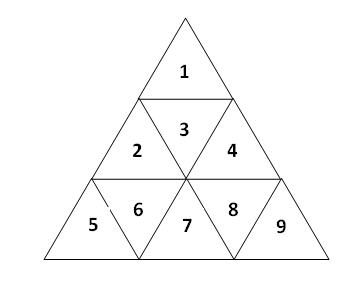-
Posts
1398 -
Joined
-
Last visited
-
Days Won
14
Content Type
Profiles
Forums
Events
Gallery
Blogs
Everything posted by CaptainEd
-
For a racing experience that is similar and yet different, I've added a boat-race variant to this challenge ().
-
This post is a variant on Superprismatic's Cartesian Racing challenge (). The movement rules are the same, but the path constraints are different--you don't have to land on specific spots, merely "round a mark". Goal: Move your boat around the course in the minimum number of moves. Movement: Your boat begins at the origin (0,0), with a velocity vector of (0,0). Before each move, you specify an acceleration vector (a,b), where a and b can independently take on integer values from the set (-1, 0, 1). The move consists of: (a) update the velocity by adding the acceleration, and then (b) move the boat by the velocity vector. Example: if the prior location was (10,11), and the prior velocity was (2,5), and you choose the acceleration vector (1,-1), the new velocity becomes (3,4) and the new location becomes (13,15). Course constraints: The course consists of an ordered series of 5 marks. A mark is a line from a point to one wall of the course. (Assume the course is "infinite", that is, from (-100,-100) to (100,100)) Your path through the course must contain a move through each of the 5 marks in that order in the specified direction. The first mark is the line (18,19)-(18,100), and must be traversed from left to right (that is, in increasing X). The second mark is the line (14,13)-(14,-100), in increasing X. The third mark is the line (34,24)-(34,100), in increasing X. the fourth mark is the line (30,9)-(30,-100), in decreasing X the finish line is the line (0,100)-(0,-100), in decreasing X. If, somehow, you fall off the board during the race, you're disqualified. Believe me, you wouldn't have won, anyway. However, if, somehow, you fall off the board while decelerating in a move AFTER the move that crosses the finish line, you will be presented your award posthumously; your race counts. Any traversals in the "wrong" direction do not count in favor or against. Any repeated traversals of the same mark do not count in favor or against. The key is that one of your traversals of the first mark must precede one of the traversals of the second, which must precede one of the traversals of the third, etc. These marks are chosen to make almost all solutions to Superprismatic's puzzle into valid paths on this course. The minimum number of moves found (so far) for Superprismatic's car-racing post is 34. Can you beat that in a boat? (Sailors, I am sorry, I understand the desire to dash across the starting line at top speed on starboard tack, but we'll start here in a luff. At least here, you can whistle for a wind.)
-
Molly Mae, I fear you are right. My heart tells me that any time I'm not accelerating or decelerating, I'm wasting time (these are places where the acceleration is 0, rather than 1 or -1). There are a half dozen of those in my 2-D solution, and a smaller number in your 1D solutions. Yet they seem to all be necessary in order to prepare to land on the next waypoint, or to do so while preparing for the subsequent path (or for marking time because of the longer distance in the other dimension). I very much enjoy your penultimate "flight home" from 35,25 in the Y dimension--two steps from 8 to 0 is awesome!
-
Never mind, I misread the problem completely
-
Good idea, Molly, that establishes lower bounds. I think I can improve your x's
-
By only two moves, Dej Mar. But squeezing one or two more moves out looks very tough, what do you think?
-
-
Oh, yeah, a prime number is one that is divisible only by itself and...and...uh...that other thing...
-
Phillip2882: Yes, but without the Log, the result is very non-uniformly distributed. Try graphing it.
-
Nothing compared to the awe I feel reading the solutions and analyses by you, plasmid, Bonanova, and superprismatic. I avoided posting a half dozen solutions that were terribly non-uniform. And, of course, aside from plotting sample results in the 3-D case, I had no proof at all. I'm still trying to digest plasmid's proof. But thank you, I enjoyed thinking of what superprismatic promised was a "simple method".
-
I don't see a problem, Bushindo. You trusted plasmid's judgement blindly, which is surely wise. Plasmid was (possibly over-)self-critical, which is surely humble and generally wise.
-
So we have solved several different problems: Plasmid and Bushindo have generated multiple uniformly distributed random numbers from one application of an RNG (plasmid did it, but didn't like it). I did it in a very area-specific manner, tedious to repurpose for another area/volume. Bonanova showed how to fill an arbitrary area uniformly (or, presumably volume/hypervolume) by generating numbers and discarding anything outside it. Plasmid and I have filled exactly the triangle (or presumably, volume/hypervolume) by generating locations that are guaranteed to span the space uniformly (we think). I like Bonanova's twist of this puzzle, try to fill any shape (circle, scalene triangle, pentagon) uniformly. But I like the attempts by Plasmid and myself to generate the point exactly inside, without having to discard any points. Can we do them both? Or is that a new puzzle? Does Superprismatic accept Plasmid's answer, or is there a better formal (ie. not geometric) solution?
-
Superprismatic, magnificent problem! Plasmid, magnificent answer! Besides the simplicity of the problem, I enjoy the tasty counterintuitivity--look at the 99 coin game, the person who "gets" to go first, and will thus draw more coins, can sometimes be forced to lose (ex. coins = 1 10 1)! Yet the first player in the 100 coin game can force at least a draw, as Plasmid showed so dramatically. Since Sp asked for the possibility of player 1 avoiding loss, Plasmid's answer suffices. It does not necessarily find the highest scoring strategy. (Hey, I'm impressed that a linear pass through the data gives a successful strategy at all!) If the coins (short game) were 7 5 20 8 6 13 19 15, Plasmid's strategy leads to player 1 getting a total of 52, but by starting by taking the 15, P1 can force a total of 54. Thank you folks for a great education!
-
Thank you for an interesting puzzle.
-
-
I'm confused for a different reason--I thought a "discrete distribution" was one in which the random variable took on one of a finite number of values. Your 3-d problem was, instead, requiring that three variables add exactly to one, but they were real, not discrete. So I'm afraid I need the education on "discrete distribution". Sorry
-
Sorry folks, the note above (#61) was intended for the simpler, more recent post (), which was the first I had ever heard of this stuff. In this case, I need to give thanks in profusion to araver, Bushindo and CarbonInTheRough for the education on Hamming distance and Hamming code.
-
Thank you, Bonanova and K-man! It took me several readings of Bonanova's explanation before I could get into the right mindset, and understand why one person's 50% chance of being right is irrelevant to the team's ability to win in most cases (most wrong guesses are wasted together on only a few team events, while all the right guesses are spread across all the rest of the team events). Thank you for that illumination. Then, K-man points to the incredible power of the Hamming distance and Hamming codes to improve the team's ability to an astounding degree! Also very educational.
-
Sorry to be a broken record. What is the probability distribution? Both Bonanova and James22 seem to know the distribution, so I recognize I'm being dense.
-
for 100% chance, don't we need to know how many of each color are to be placed? Otherwise, how can anybody infer their color? Am I missing something?
-
These problems with up to two bad coins are a real eye-opener for me: I keep thinking I ought to be able to invent the next weighing, and I keep being wrong. Thank you for the educational opportunity.
-
My solution is very heavy handed. I would consider this totally ugly except that Newbie has managed to find this bizarre way to come up with exactly 3^5 cases, so that a balance scale can divide into three cases. I've got to imagine pcDixie is Very Deep. I'm certain pcDixie is Much Deeper Than I, because I can neither fathom how you could come up with the exact conditions that result in 3^5 cases, nor intuit the weighings I came up with. But, enough about me... Actually, pcDixie, I'm sorry to sound like I'm griping--I'm totally amazed at your ability to discover (or invent) that problem, and I greatly enjoyed both considering how to construct the first three weighings, and how to make an Excel macro to enable me to see the results of a weighing on a bunch of cases. So, thanks so very much! (I just wish I understood my answer, grumble...)


